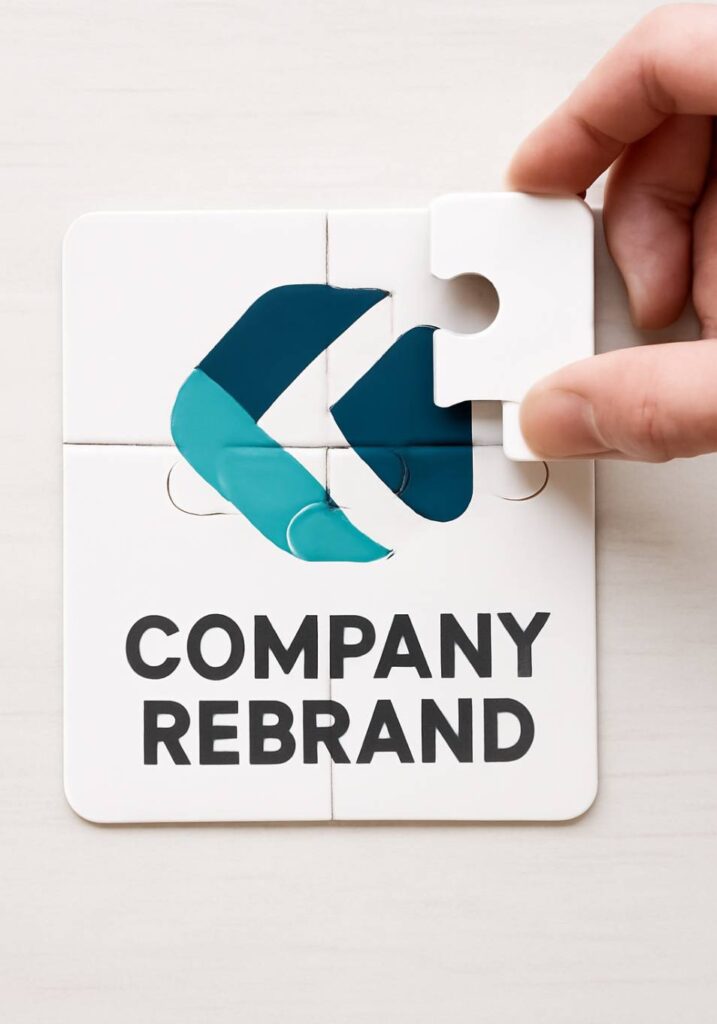My 5-Phase Strategy: How to Roll Out a Rebrand Successfully
In 2023, I was part of executing a major rebranding project at my previous organisation. That experience, with all its complexities and pressures, taught me an invaluable lesson: a brilliant rebranding strategy can either soar or stumble, and the outcome almost always hinges on the quality of the rollout. It solidified my perspective on how to roll out a rebrand effectively, not just creatively.
Many businesses pour 90% of their energy into designing the perfect logo, leaving the actual launch plan as an afterthought. This is a critical mistake. A rebrand isn’t just a new visual identity; it’s a public declaration of your company’s evolution. The rollout is your first, most tangible proof point of that new promise.
This blog is my answer to the question of how to roll out a rebrand without the chaos. It’s a detailed guide broken down into five distinct phases, designed to create a seamless and impactful transition.
Phase 1: The Strategic Foundation (The Pre-Launch Plan)
The first step in understanding how to roll out a rebrand is realising that the most important work starts months before the public ever sees a new colour palette. This foundational phase involves meticulous planning and establishing your operational command centre.
Your central tool here is the Brand Implementation Plan. This is more than a checklist; it’s your single source of truth. To build it, I recommend using a collaborative project management tool, such as Asana or ClickUp. Create sections for each department (Marketing, Sales, HR, IT, and Legal) and list every single asset that requires updating. Assign a specific owner, a due date, and a status to each line item. This includes everything from the sign on your building and the hold music on your phone system to the favicon on your website tab and the boilerplate in your legal contracts.
This plan must also include a risk assessment. What happens if the new social media handle is already taken? What if a key vendor can’t meet the deadline for new packaging? Thinking through these potential roadblocks now prevents crises later.
Finally, establish your “Brand Command Center”, a core team responsible for overseeing the entire rollout. In my experience, this team must include a project lead, a marketing lead, a creative director, a technical lead from IT (to handle the digital migration), and a representative from HR or Internal Comms. This cross-functional group ensures all bases are covered and that decisions can be made swiftly.
Phase 2: The Internal Launch — Your Most Important Audience
This is the most overlooked, yet, in my view, the most critical aspect of how to roll out a rebrand. You cannot successfully rebrand to the world until you have successfully rebranded to your own team. Your employees are your first and most powerful brand ambassadors. A confused, uninspired, or cynical team can unintentionally sabotage even the best-laid plans.
- Host an “Insider” Reveal: Go beyond a simple email announcement. Gather your entire team for an all-hands meeting or a virtual event. The agenda should be inspiring and informative. I suggest having the CEO open with the high-level vision, followed by the Head of Marketing explaining the “why” and the research behind the change. Finally, the Creative Director can unveil the new identity and walk through the design choices. A candid Q&A session at the end is non-negotiable to address concerns head-on.
- Equip Your Brand Champions: Don’t just show them the new brand; give them the tools to use it confidently. The “Brand Champion Toolkit” I create is a digital folder containing all essential assets, including new logos in various formats, official presentation templates, email signatures, social media banners for personal profiles, and a concise brand style guide. Most importantly, it includes a detailed FAQ document addressing questions like, “Why did we rebrand?”, “What is our new elevator pitch?”, and “How do I respond if a customer says they don’t like the new logo?”.
- Make it a Celebration: A rebrand signifies a new chapter. Mark the occasion with some new company swag, a catered lunch, or a team social event. This fosters positive emotional momentum and a sense of shared ownership, which is invaluable for a smooth transition.
Phase 3: The Digital Transition — A Meticulous Migration
Once your team is on board, the next step is the technical migration of your digital assets. This requires surgical precision. A single broken link or an old logo lingering on a forgotten landing page can undermine the professionalism of the entire effort. Your Brand Implementation Plan is your bible here.
While the main digital assets are obvious, it’s the forgotten ones that often cause problems. My “don’t forget” checklist includes:
- Automated and transactional emails (password resets, shipping confirmations, out-of-office replies).
- Favicons and app icons.
- App store listings and screenshots.
- The branding within third-party tools you use, like chatbots, scheduling software, or survey platforms.
- Digital signatures and branding on invoices and financial documents.
Furthermore, consider the SEO implications. If your rebrand involves changing your company name and domain, a comprehensive 301 redirect strategy is essential to transfer your existing search authority to the new domain. You must notify Google Search Console of the change of address. This technical backend work is a crucial part of learning how to roll out a rebrand in the modern era.
Phase 4: The External "Big Bang" Launch — Telling Your New Story
With your internal and digital houses in order, it’s time to share your message with the world. The goal here is not just to announce a new look, but to communicate a new, compelling story with clarity and confidence. A multi-channel, orchestrated approach works best.
- The Cornerstone Announcement: This should be a rich, detailed piece of content on your new website. I recommend a dedicated landing page that includes a letter from the CEO explaining the vision, a short video telling the story of the rebrand, a side-by-side comparison of the old and new identity (with the rationale), and perhaps testimonials from employees or key partners. This page serves as the official narrative you can point everyone towards.
- Segmented Customer Communication: Don’t send a single, generic email to all customers. Tier your communication. Your top clients might deserve a personal phone call or a detailed email from their account manager. Your loyal customer base should receive a thoughtful email explaining the change and what it means for them. The key is to make them feel valued and part of the journey.
- Coordinated PR and Media Outreach: Prepare a press kit with high-resolution logos, executive headshots, and the official press release. Reach out to key industry journalists and influencers, giving them early access under embargo to help build buzz and ensure accurate coverage on launch day.
- Launch a Supporting Campaign: Don’t just show the new logo; show the new brand in action. Launch a new advertising or social media campaign that brings the brand’s new promise to life through storytelling, not just a visual reveal.
Phase 5: Post-Launch Reinforcement & Monitoring
The work isn’t over on launch day. In many ways, it’s just beginning. This final phase is about reinforcing the new brand and actively managing the transition in the real world.
Be prepared for feedback, both positive and negative. Change can be jarring for some long-time customers. Monitor social media mentions, brand keywords, and customer service channels relentlessly for the first few weeks. Respond with empathy, reinforce the “why,” and thank people for their passion for your brand.
This is also the time to measure the impact. I recommend creating a “Brand Health Dashboard” to track key metrics post-launch. This should include:
- Branded search volume.
- Social media sentiment analysis (positive, neutral, negative mentions).
- Website traffic and engagement.
- Press mentions and their estimated reach/value.
- A follow-up brand perception survey was sent out 3-6 months after the launch to measure shifts in awareness and sentiment
Conclusion: A Rebrand is a Promise in Action
Ultimately, knowing how to roll out a rebrand is less about managing a checklist and more about leading people, employees, customers, and partners, through a significant change. The creative strategy gives your brand a new voice, but the rollout is what gives it a heartbeat. It’s the moment your new promise is either fulfilled or broken. With a thoughtful, phased approach, you can ensure your new brand doesn’t just launch; it soars.

If you’ve been part of a rebrand, what was the single biggest lesson you learned during the rollout? I’d love to hear about it in the comments.
A short note: This blog was written by me and refined by Generative AI. 😉




